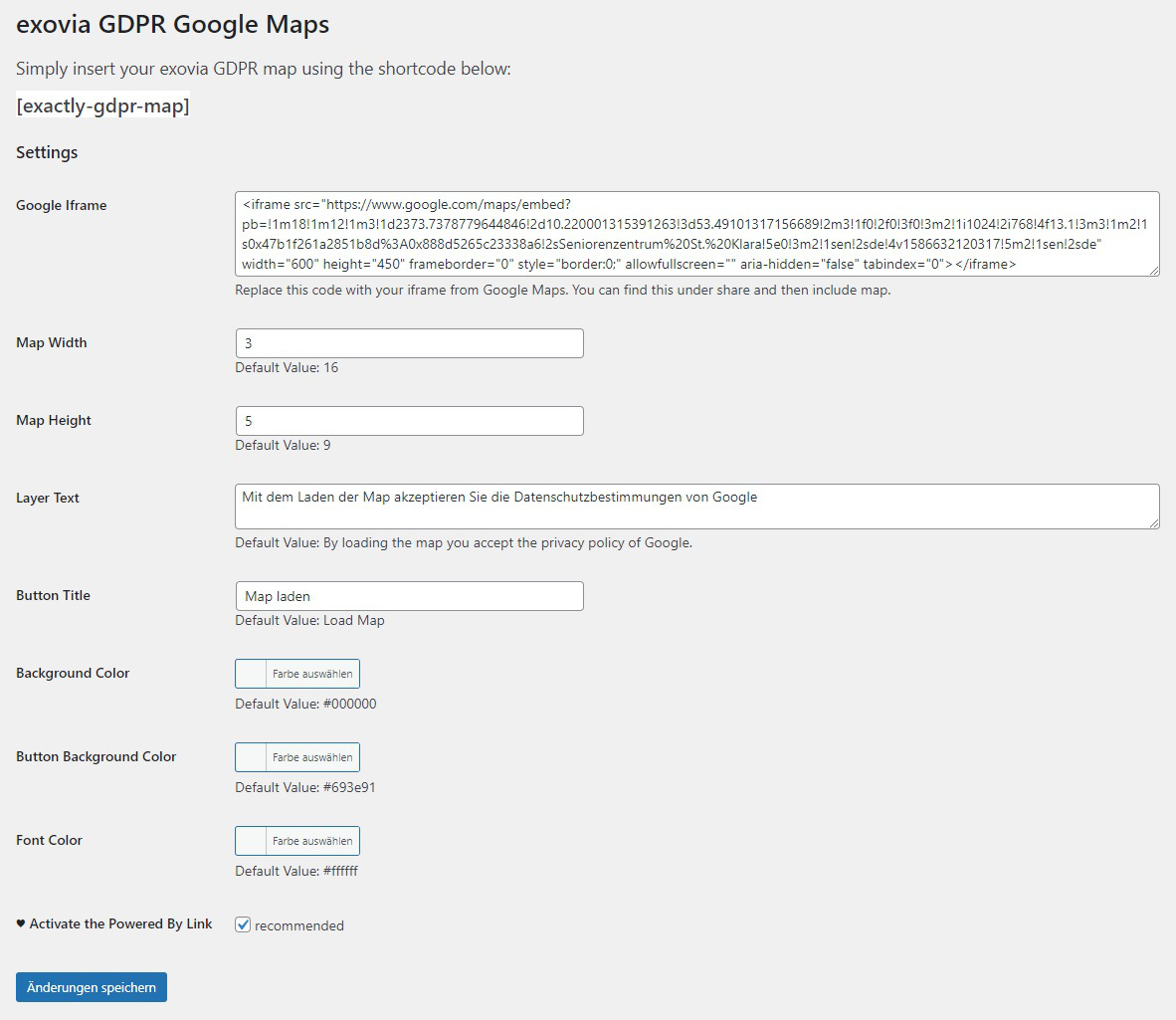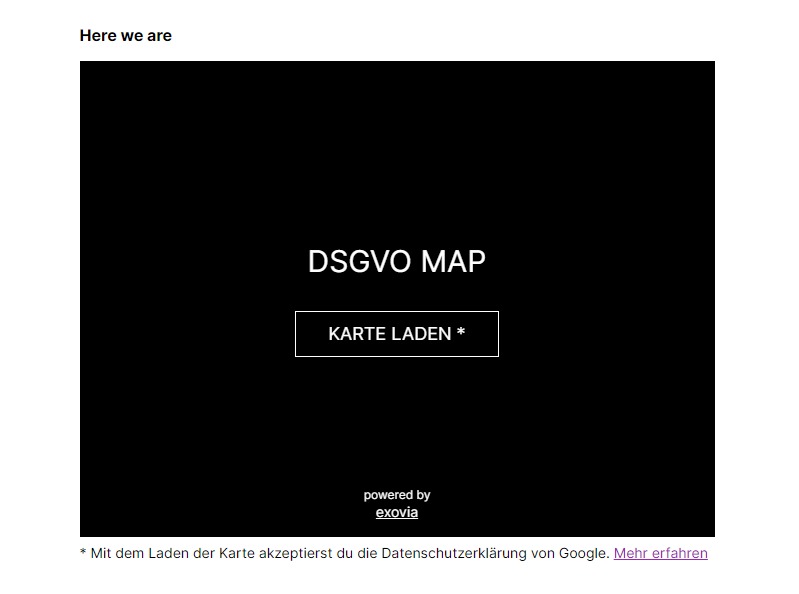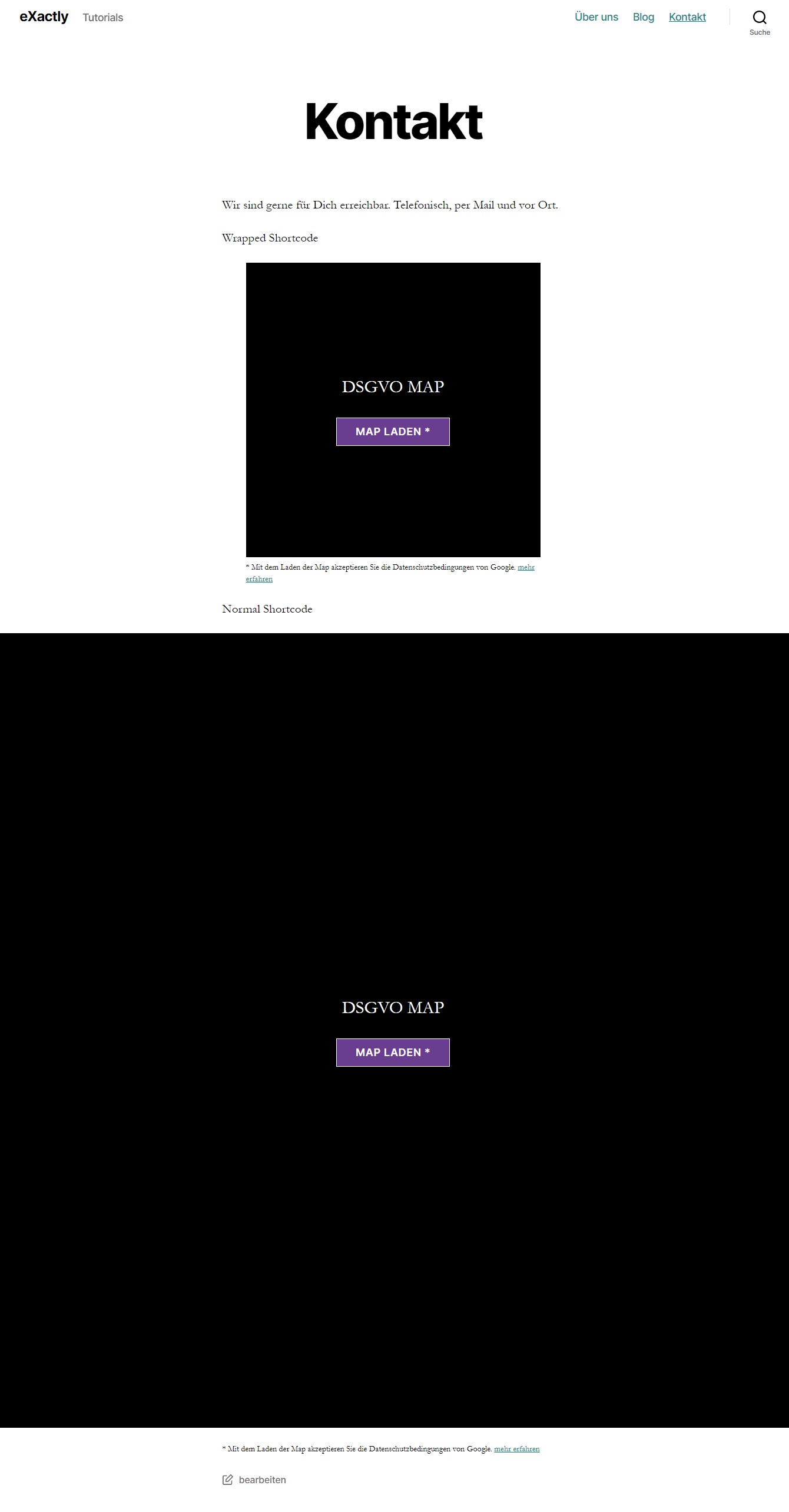
exovia GDPR Google Maps Plugin
exovia GDPR Google Maps enables you to integrate Google Maps in a privacy compliant manner that respects the privacy of your visitors.
You would like to integrate Google Maps on your website and are looking for a data protection compliant solution? You would like to show your website visitors where to find you, but at the same time you want to respect their privacy?
This is exactly where trusted plugin supports you and ensures that you can integrate Google Maps on your website free of charge and in compliance with data protection regulations.
Instead of a map, we load a colored placeholder of your choice in the first step. Supplemented by a few words of your own, it becomes an attractive interaction surface for your visitors.
No data will be transferred to Google until your visitors click on the consent button. Only then will the correct map be loaded and your selected address displayed in Google Maps.
Both your placeholder and your Google Maps are mobile optimized and automatically adjust to the display size. You can also give both of them a maximum width to achieve the best optical result.
In this way you can protect the privacy of your visitors in accordance with DSGVO and at the same time give them the desired orientation to find you.
Here you can find a live demo of a GDPR map created with the plugin.
YOUR 5 EASY TODOS
- Install and activate the plugin “exovia GDPR Google Maps”.
- Go to maps.google.com, enter your address in the search box and click Share
- Embed the copied HTML code into the iframe field in your plugin settings
- Adjust the colors and sizes of “exovia GDPR Google Maps” to your color scheme, web design and website conditions. Simply from your WP backend.
- Use the shortcode:
[exactly-gdpr-map]wherever you want your map to appear – e.g. on your contact or office pages – or even in the footer.
WHAT THE PLUGIN DOES FOR YOU
- Until the user’s consent has been explicitly given, it prevents the connection to Google’s servers (GDPR) and thus protects the privacy of your visitors.
- Thanks to an adjustable level, it reserves space for the card until it is loaded, thus stabilizing the design and impact of your website.
- Based on your color and size wishes, it ensures that your placeholder automatically adapts to your layout.
- Whether Classic Editor or Block Editor (e.g. Gutenberg Shortcode Block): the plugin is compatible with both and makes sure that your settings are accepted and realized.
- You have a multilingual site? The plugin works in all languages and can be designed and re-written for specific pages. DE and EN are already translated as languages.
- It provides a required link to the Google terms of use and
- offers a simple short code that allows you to use the secured map anywhere.
WHAT THE PLUGIN IS NOT FOR
- Maps generated with Google Maps Platform
- Handling of different maps (Sorry. But feel free to let us know if there is interest. If enough people get together we will adapt or write a new plugin).
- Saving users content settings in web databases. Last but not least, this is why the plugin is simple and secure.
BUGS & FEEDBACK
Your feedback is important to us. If you find mistakes, have wishes, ideas or suggestions, please send us an e-mail to [email protected].
This plugin was developed with love by our Hamburg-based web design agency exovia.
Legal notice (German): www.exovia.de/impressum/
You are free to use it on any website across countries to protect the privacy of your users.
Note: Of course, activating this plugin cannot guarantee that your website is completely compliant with the GDPR. When using Google Analytics or Facebook pixels, for example, other or additional measures must be taken.
Installation
This section describes how to install and run the plugin.
- login to /wp-admin
- go to Plugin -> Add new plugin
- Search for “exovia GDPR Google Maps”
- Install and activate the plugin directly from your WordPress backend
- Configure the “exovia GDPR Google Maps”, via the plugin settings
- Visit Google Maps to get your iframe code. For more information visit Google Support Forum
- Paste your code into the iframe input field of the plugin
- Use the shortcode:
[exactly-gdpr-map]anywhere on your website. - Wrapp your map as you wish by giving it a max-width
- Look at your new Google Maps
Alternatively, the plugin can be installed by uploading it to your plugin files directory ‘wp-content/plugins/plugin-name’. The activation as well as all further steps are then carried out as usual from the WP-Admin area.
Screenshots

embed the copied HTML code into the iframe field in the plugin settings and adjust the colors and sizes of eXactly GDPR Google Maps to your color scheme and website conditions
![insert the shortcode <code>[exactly-gdpr-map]</code> in the text field - without block editor](https://ps.w.org/exactly-gdpr-google-maps/assets/screenshot-2.jpg?rev=2291295)
insert the shortcode
[exactly-gdpr-map]in the text field - without block editor![insert the shortcode <code>[exactly-gdpr-map]</code> in the text field - with block editor](https://ps.w.org/exactly-gdpr-google-maps/assets/screenshot-3.jpg?rev=2882222)
insert the shortcode
[exactly-gdpr-map]in the text field - with block editor![insert the shortcode <code>[exactly-gdpr-map]</code> in the shortcode widget, wrapped or normal](https://ps.w.org/exactly-gdpr-google-maps/assets/screenshot-4.jpg?rev=2291295)
insert the shortcode
[exactly-gdpr-map]in the shortcode widget, wrapped or normal
your placeholder could look like this before your visitors agree. There is no connection to the Google server yet.

this is what your placeholder could look like in wrapped and normal state.

view your map - now after approval of the user and connection to Google.

google maps iFrame code as basis for the integration into your plugin

this is how your placeholder might look on small displays

mobile view of your map - now after user approval and connection to Google.
FAQ
- Open Google Maps.
- Search for your desired address to customize the map to your liking.
- Open the menu in the upper left.
- Select split map or embed map.
- Click on embed Map.
- Copy the code and paste it into the iframe input field of the plugin
The General Data Protection Basic Regulation (DSGVO) is a legal framework regulating the collection and processing of personal data of persons living in the European Union (EU).
The Regulation applies regardless of where websites are located.
It must be complied with by all websites that attract European visitors. Even if goods and services are offered that are not specifically aimed at EU citizens.
Shortcodes are short code characters that allow you to add dynamic elements, such as Google Maps, within your WordPress content area in compliance with your privacy policy.
The shortcut for the plugin is [exactly-gdpr-map].
The shortcode can be added either via normal text widgets or, best of all, via the shortcode widget [/], which is specially designed for short codes.
HTML widgets are not suitable for this.
Just use the extra for shortcodes provided Gutenberg block, which is included by default in WordPress.
Changelog
1.0.13
- php 8.0 compatibility, Tests with WP 6.5.5
1.0.12
- php 8.2 compatibility, Tests with WP 6.5.5
1.0.11
- Better Gutenberg docs
1.0.9
- Multilingual HTML templates on the Settings page
- Bugfixes JQuery Handler on Settings Page
- Reordered Change log
- Better Docs, Tests with WP 6.2.2
1.0.8
- More robust error handling for xml errors for maps iframe
- tests with WordPress Version 6.2
1.0.7
- Update for current WP Version
- Implementing css aspect ratio instead of padding-hack
- Correct styling for gutenberg without wrapper divs
- adding possibility for editing anchor text
- new Gutenberg Screenshot
- Adding “What the plugin is not for…” in docs
1.0.6
- Tests for current WP Version
1.0.5
- Update change Plugin Author to exovia
- Minor Changes in Docs (readme.txt)
- Update of Screenshots
1.0.4
- Update for current WP Version
- Bugfix with initial Plugin Loading through WP Plugin Repo
1.0.3
- Update for current WP Version
1.0.2
- Update for current WP Version
1.0.1
- Update for current WP Version
1.0
- Addition of the initial version of the exovia GDPR Google Maps plugin